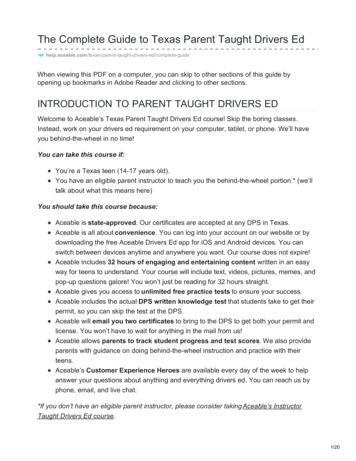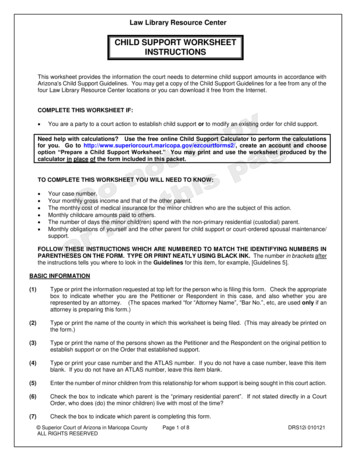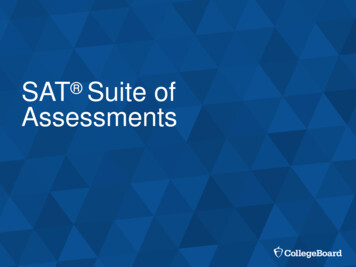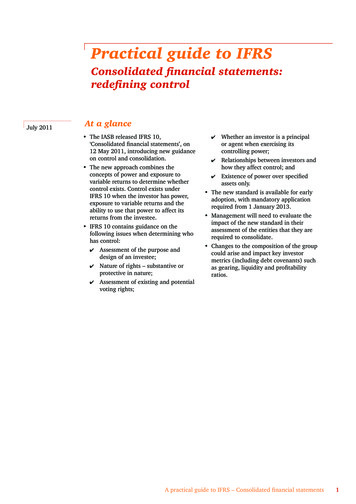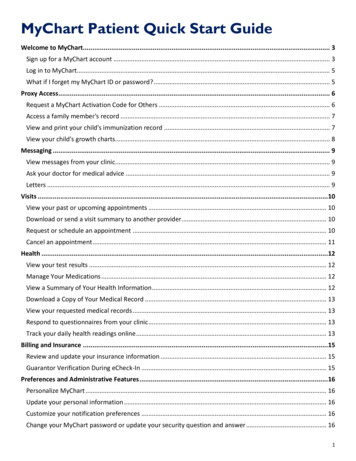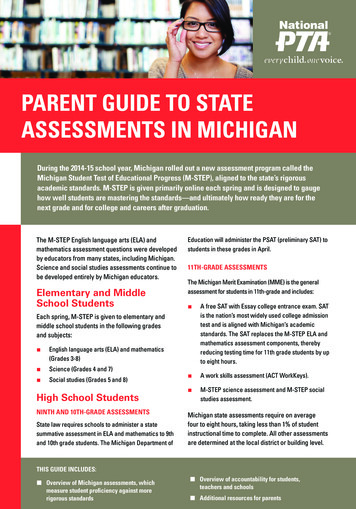
Transcription
PARENT GUIDE TO STATEASSESSMENTS IN MICHIGANDuring the 2014-15 school year, Michigan rolled out a new assessment program called theMichigan Student Test of Educational Progress (M-STEP), aligned to the state’s rigorousacademic standards. M-STEP is given primarily online each spring and is designed to gaugehow well students are mastering the standards—and ultimately how ready they are for thenext grade and for college and careers after graduation.The M-STEP English language arts (ELA) andmathematics assessment questions were developedby educators from many states, including Michigan.Science and social studies assessments continue tobe developed entirely by Michigan educators.Elementary and MiddleSchool StudentsEducation will administer the PSAT (preliminary SAT) tostudents in these grades in April.11TH-GRADE ASSESSMENTSThe Michigan Merit Examination (MME) is the generalassessment for students in 11th-grade and includes: A free SAT with Essay college entrance exam. SATis the nation’s most widely used college admissiontest and is aligned with Michigan’s academicstandards. The SAT replaces the M-STEP ELA andmathematics assessment components, therebyreducing testing time for 11th grade students by upto eight hours. A work skills assessment (ACT WorkKeys). M-STEP science assessment and M-STEP socialstudies assessment.Each spring, M-STEP is given to elementary andmiddle school students in the following gradesand subjects: English language arts (ELA) and mathematics(Grades 3-8) Science (Grades 4 and 7)Social studies (Grades 5 and 8)High School StudentsNINTH AND 10TH-GRADE ASSESSMENTSState law requires schools to administer a statesummative assessment in ELA and mathematics to 9thand 10th grade students. The Michigan Department ofMichigan state assessments require on averagefour to eight hours, taking less than 1% of studentinstructional time to complete. All other assessmentsare determined at the local district or building level.THIS GUIDE INCLUDES: Overview of Michigan assessments, whichmeasure student proficiency against morerigorous standards Overview of accountability for students,teachers and schools Additional resources for parents
ASSESSMENTS FOR SPECIAL POPULATIONSAn alternate assessment called MI-Access is available tostudents with disabilities whose Individualized EducationalProgram (IEP) team has determined that general assessments,even with accommodations, are not appropriate. Moreinformation about MI-Access is available at MI.gov/MI-Access.An English language proficiency assessment called WorldClass Instructional Design and Assessment (WIDA) is providedfor students who are learning the English language. Additionalinformation about WIDA can be found at MI.gov/WIDA.WHY NEW ASSESSMENTS?Types of assessmentsClassroom-based: Individual tests given byteachers as needed throughout the year toassess knowledge and skills in specific areasBenchmark: The same test repeated at setintervals to measure student growth over timeSummative: End-of-year assessmentsadministered by the state to measure studentperformance against a common set ofstandardsTeachers and principals talk a lot about assessments, whichare used to measure students’ academic achievement. Thisdocument highlights the end-of-year summative assessments,This document addresses summative assessments.which (1) measure student progress toward mastering statestandards, and (2) provide information on program and school effectiveness. There are three main types of assessments(see box at right).The M-STEP summative assessments address concerns that parents, educators and employers have had about stateassessments in the past—namely that they measured ability to memorize facts, rather than the skills to think critically andapply knowledge.
Information on M-STEP summative assessments.M-STEP has fewer multiple-choice questions and more questions that requireproblem-solving and critical thinking skills.The assessments will enable educators to deepen their understanding of studentprogress from grade to grade—and, just as importantly, identify instructional supportswell before students enter college or the workforce.ELA assessments: Students read more complex fiction and non-fiction texts, and use evidence fromthese texts to answer questions, make inferences and present persuasive arguments. Literacy is emphasized across all subjects, not just English language arts. Writing is tested at every grade level.Math assessments: Go beyond multiple-choice questions — students are presented with multi-stepproblems, conceptual questions and real-world applications. Students are expected to solve mathematics questions and are asked to not onlyget answers correct but explain how they arrived at their answer. Fewer topics are covered in greater depth.
Benefits of Michigan’sState Assessments: Scores provide students, parents and teachers with insight into career and collegereadiness early enough to address issues and provide extra support where needed. Starting in 2016, M-STEP ELAand mathematics assessmentsNOTE: While taking advantage ofbecame “computer-adaptive teststechnology, assessments are designedto work with the technology resources(CATs),” which adjust the difficultyavailable in schools today. Most schoolof questions based on studentdistricts in Michigan will be administeringresponses. A student who answersstate assessments online. A paper-andcorrectly will receive a morepencil option remains available uponchallenging subsequent item whilerequest.an incorrect answer generatesan easier question. This methodprovides students with a more engaging test experience, is more time-efficient and producesmore accurate results than traditional methods, particularly for low- or high-achievingstudents. The assessments provide accurate measures of achievement and growth for all students—including those with disabilities and English language learners—allowing these studentsto perform to their potential. The goal is to make the assessments more accessible and toproduce results that are valid for all students. For students with disabilities, the online assessments address visual, auditory and physicalaccess barriers. Students are able to take a test individualized to meet their needs at thesame time as other students in their class. Helpful tools have been developed for English language learners to demonstrate theirknowledge, regardless of their level of proficiency in English.PTA.org
Sample Questions by Grade LevelThe following questions are representative of those found on the M-STEPassessments. For more examples, visit the Michigan Department of Education’sOnline Practice for M-STEP English language arts, mathematics, science and socialstudies at michigan.gov/mde/0,4615,7-140-22709 70117-350540--,00.htmlFIFTH-GRADE MATHEMATICSThe bed of a truck is stacked with boxes of paper. The boxes are stacked 5 boxes deep by 4 boxes high by 4 boxesacross, as shown in the picture.When the driver is in the empty truck, the mass is 2948.35 kilograms.The mass of 1 box of paper is 22.5 kilograms.The driver delivers some of the boxes of paper at his first stop.The truck has to drive over a bridge on the way to the next stop.KEY1 boxof paperTrucks with a mass greater than 4700 kilograms are not allowed todrive over the bridge.Enter the minimum number of boxes of paper the driver must deliver at the first stop to be allowed to drive overthe bridge.X1234 5 678 90.
Sample Questions by Grade LevelSIXTH-GRADE ENGLISH-LANGUAGE ARTSSAMPLE QUESTIONA student is writing a report about sleep. Read both sources and the directions that follow.Source 1: “During Sleep” by Dr. Howard DellIf you are like some people, you may think that sleep is a process during which the body and brain shut off, butthis is not the case. The body goes through a series of stages during sleep in which body and brain activitychange. Most of these changes are neither noticed nor remembered. However, sleep does usually follow apattern. Muscle activity and breathing slow in the initial stages of sleep. The body’s temperature alsodecreases. Sometimes during sleep, the heart can begin to beat more quickly, blood pressure can rise, andmany muscles experience small movements. These changes often happen during dreams.Source 2: What Happens While You SleepSLEEP STAGEDESCRIPTIONStage 1 Light SleepThe muscles relax, eye movement slows and thoughts begin tofade. A person may be easily awakened.Stage 2 Light SleepEye movement stops, and a person can experience brief dreams.Body temperature begins dropping and heart rate slows.Stage 3 Moderate-Deep SleepThe body temperature lowers, and a person is difficult to awaken.Stage 4 Deep SleepThe brain uses less energy. The body temperature lowers morethan in moderate-deep sleep. A person may sleepwalk.REM Sleep (REM rapid eye movement)Most dreams occur during this stage. The brain uses energy aseyes move quickly, even though the eyelids are closed. Heartrate and blood pressure increase, but many of the large bodymuscles are inactive.The student took notes about information in the sources. Select two notes that correctly paraphrase, or restate,information from both sources.We dream several times each night.People can sleepwalk during a stage of deep sleep.People can be easily awakened from sleep.Our bodies and brains continue to work during sleep.We do not remember what happens during sleep.During some stages of sleep, our bodies decrease in activity.11TH-GRADE SAT INFORMATION AND SAMPLE TEST ITEMSBeginning in spring 2016, Michigan will administer the SAT college entrance exam as part of the MichiganMerit Examination for students in Grade 11. For more information and practice test items, visit the MichiganSAT website at tice.
What Parents Can ExpectThe M-STEP is designed to measure rigorous content expectations of the statestandards. Because the tests measure complex skills, which are different fromthe skills measured by previous state tests, scores may look lower. In many cases,students aren’t doing worse—it’s just that the bar is higher.As students and teachers gain the skills and knowledge needed to meet higher standards, performanceis also expected to improve over time. In other states where higher standards are taught andassessments have been aligned to those standards, student performance has improved.State assessments require less than 1% of student instructional time during a school year. All otherassessments are determined at the local district or school level.M-STEP Parent ReportsThe M-STEP parent report provides a snapshot of how your child is progressing and shows where heor she excels or needs more support. This information, along with classroom grades, teacher feedbackand scores on other tests, will help give a more complete picture of how well your child is performingacademically.The score reports describing students’ results on the tests may be very different from what parents haveseen in the past.More information on M-STEP and what a parent report contains is available athttps://www.youtube.com/watch?v NYBG VnkshE.AccountabilityMichigan’s MI School Data website, mischooldata.org, provides the public with a wide variety ofinformation, including school, district and state assessment results.Over the past several years, Michigan has used a color-coded scorecard as part of its accountabilitysystem. During the state’s transition to M-STEP, accountability scorecards including school rankingswere not released until January 2017 when multi-year assessment data was available.How will schools support struggling students?Schools have created a variety of models to assist struggling students. Check with your school for thetype of supports available.PTA.org
Take ActionParents are their child’s best advocates. As a parent and your child’s first teacher,you should be informed about the local district and building assessments, as wellas the State of Michigan assessment and accountability system. Parents andfamilies must be at the table with school leaders and school districts to ensure thattesting is implemented well and with enough resources to ensure success.For additional details on the state assessment and accountability system, please visit theMichigan Department of Education’s Office of Educational Assessment and Accountabilitywebsite at www.mi.gov/oeaa. The M-STEP testing calendar is available online athttp://www.michigan.gov/documents/mde/3-Year Calendar 002 517993 7.pdfHere are some questions you might want to consider asking your local school: How many local assessments will my child take this school year, and where can I access/view theassessment calendar? What will happen if my child does not meet proficiency on the new assessments? How will the results of tests be used to support my child’s learning? What can I do, as a parent, to help my child do his or her best? How will school evaluations be affected, based on results of the new assessments?Also, be sure to speak with your local school administrators! Ask them to host a parent night in thespring to explain the tests, and in the fall to explain test results.Below is the list of policies and practices that National PTA supports. National PTA believes that valid assessment does not consist of only a single test score, and that at notime should a single test be considered the sole determinant of a student’s academic or work future. National PTA supports nationally agreed-upon voluntary standards if they are derived by consensus atthe state and local levels. Parents must be involved in this process. National PTA believes that assessments provide valuable information to parents, teachers and schoolleaders about the growth and achievement of their students. Furthermore, having annual data onthe performance of students can help inform teaching and learning, as well as identify achievementgaps among groups of students within a school and among a school district. National PTA believesassessments are essential to ensure that all students receive a high-quality education.PTA.org
Preparing and Supporting Your Child Review Michigan’s System EducationAssessment What It Is, What It Means,And What It Offers at http://www.michigan.gov/documents/mde/2017 MI AssessmentSystem - What it is What it meansWhat it offers jl 555024 7.pdf, whichincludes valuable information on the testand the spring testing calendar.Encourage your child to practice onlinesample test items for M-STEP Englishlangauge arts, mathematics, science andsocial studies at home if possible to becomefamiliar with the test layout and types ofquestions on the test. Sample test itemscan be found at http://www.michigan.gov/mde/0,4615,7-140-22709 70117-350540--,00.htmlEncourage your child to practice onlinesample test items for the PSAT and SAT.PSAT and SAT sample test items canbe found at tice.Work with your child’s school and teachersto ensure there will be regular and clearcommunications from the school on theassessments, test preparation that could bedone at home, and how the results will be used. Discuss the tests with your children. Makesure they feel comfortable and understandwhy they are taking a test. With older children, explain that theassessments were created to makesure they are on track to succeed aftergraduation, and to identify any issues earlyenough to give them more support. Explain to your child that the M-STEP testis challenging. Tell your child you have highexpectations and that you and the teachersare there to help every step of the way. Watch the M-STEP Parent Report Video athttps://www.youtube.com/watch?v NYBGVnkshE, which explains the report you willbe receiving from your child’s school withhis or her test results. Make sure your child has a comfortableplace for studying and is prepared mentallyand physically for a test—getting plenty ofrest and nutritious food. Review test results with your child and hisor her teacher.Staying informed and involved Become familiar with Michigan’s standards that are the basis for classroom instruction andstate assessments, visit Michigan.gov/academicstandards. Monitor your child’s progress and regularly communicate with your child’s teachers. If yourchild needs extra help or wants to learn more about a subject, work with his or her teacher toidentify opportunities for tutoring, after-school clubs, or other resources. Read all comments written by the teacher. Ask teachers to explain anything that is unclear, anddiscuss how you can best work together to address areas of improvement for your child. Meet with your child’s teacher as often as possible to discuss his or her progress. Ask foractivities to do at home to help prepare for tests and improve your child’s proficiency. Remember, tests are a snapshot of student performance on a given day and are not the onlymeasures of what a child can do. Copyright 2016 National PTA. All rights reserved.
During the 2014-15 school year, Michigan rolled out a new assessment program called the Michigan Student Test of Educational Progress (M-STEP), aligned to the state’s rigorous academic standards. M-STEP is gi
